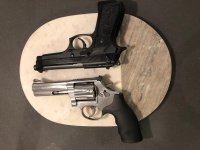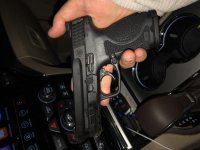I'd like to second what others have said here, particularly Rastoff. I've spent more than 40 years now making a living wearing and using guns as a cop, firearms trainer, range and gun shop owner, writer and competitor all at different points in time. I've also been involved in agency acceptance trials for multiple handguns.
What I have found is that among modern firearms types, each type on the market generally exists for a different reason and different requirements. For example, the Shield, which is a great pistol, and in my opinion one of the very best slim 9mm subcompacts along with the Walther PPS , was designed with a particular set of parameters in mind. To the engineers, the priority on that class of gun is concealable size, comfort for daily wear, combat levels of accuracy as opposed to match grade performance, and reliability under normal conditions.
The company has made the assumption that the little gun will be carried under generally normal concealed conditions by a civilian or an off-duty cop, where it must be reliable with a lack of lubrication, or exposure to lint and dust, but the job does not call for use under "battlefield conditions". Price is also a consideration, especially for a handgun to be purchased by an end user rather than a tax funded agency. Overall, S&W has done a very good job of designing this pistol for its intended audience.
By contrast, let's look at a full-sized law enforcement or military duty sidearm. It must be relatively easy for a wide variety of people at different skill levels to shoot with limited training. Since it may well be the only weapon an officer has in his possession when encountering multiple threats, it requires a higher magazine capacity than the little Shield you tuck in your waistband. It may also need to be shot at longer distances than the average private citizen is likely to encounter in a parking lot mugging. Even if compact, it may well be required to use larger magazines from the officer's service pistol if used as a backup weapon.
If it has been submitted as a military sidearm, it is expected to function under extremes of temperature, in dirt and mud, and lately in sand. It may very well be shot more than a CCW piece, and must survive that use, as well as potential misuse and abuse by minimally trained staff. It may very well require interchangeable back straps to accommodate different hand sizes with the same pistol. It may need a modular design allowing for repair by a unit level armorer.
All of these things are MUCH easier to design into a physically larger pistol. And in the pistol intended for military or police use, these factors will normally take precedence over considerations of concealable size, lighter weight, or lower price. While all mechanical devices will eventually fail, Rastoff is 100% correct that a consumer-grade subcompact pistol will likely fail earlier than a service weapon designed for hostile environment use. Will this likely be an issue for normal people who use the consumer product as intended? Probably not.
Then there is the issue of the caliber of the gun. Each handgun caliber, in my experience, has a "natural home" as I call it, a size of handgun it performs best from. For example, years of experience have taught me that for most folks, a .45 ACP requires a full sized grip, and is probably at its best in a heavier pistol. Some disagree. The .40 is great in a mid-sized pistol that was designed for it (same for the .357 SIG) but in smaller guns not so much. And the 9mm can be controlled effectively by most people in a pistol the size of a Shield, for most situations, even though it also works well in larger, heavier handguns.
As another member correctly commented, there are very real differences in how a shooter may perform when using a more compact, lighter gun as opposed to something with just a bit more size and weight. For a given caliber, larger heavier guns will usually have less felt recoil, less muzzle flip, and will be a bit more forgiving of shooter error than the small compacts. Few people understand this, because very few people test themselves under realistic conditions and while comparing guns, and fewer still have any idea of what they actually need to be able to hit, practicing on targets the size of a barn, when in fact the actual vital area of a human is the size of a piece of notebook paper.
All of this matters, but few seem to think about these things when they choose a defense pistol. There are issues beyond convenience. Remember, you are launching deadly projectiles into areas that may also contain innocent bystanders, so you must not miss, even under pressure. I personally think that in the quest to give the inexperienced consumer what they think they want, some manufacturers have gone overboard in trying to provide the smallest, lightest autopistol that will sell to everyone, but that only a few experts can shoot worth a damn under pressure. From my observations, Smith and Wesson avoided this pitfall with the Shield. But if you go much smaller than that, you are in the territory of an "experts only" pistol. Recently I watched a video the other day where a guy shot his brand new SIG P365 at an 8.5 x 11 inch piece of copy paper at 10 yards, and clean missed it with four out of ten shots once he had to shoot under pressure. He thought that was good enough, and it just isn't. He was completely focused on how small and light the pistol was, and completely unconcerned that under no life and death stress, he had just missed with 40% of his shots. Had he run the exact same drill with something just a bit larger and heavier, I'm betting his outcome would have been better.
So there are many reasons why one might choose a somewhat larger pistol instead of the smaller one. You may not "need" more than one, but the one you choose should be tailored to your level of skill, your requirements, and your mission. That's why we still have so many different guns available to us.


